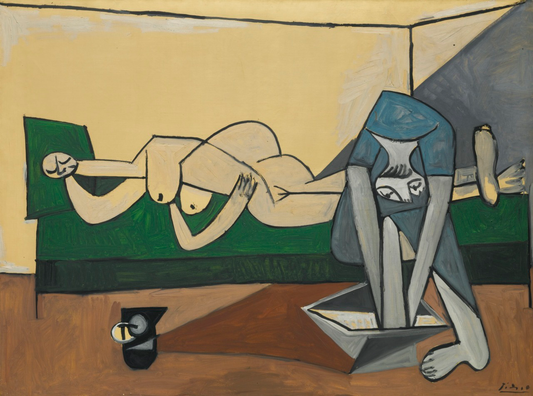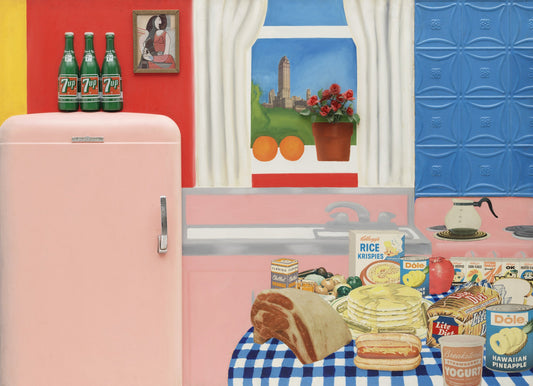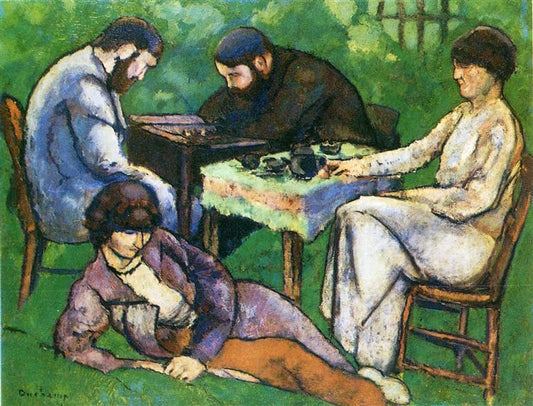Feature image: Gertrude Abercrombie, Split Personality, 1954 via Colossal
Beyond Dreams: The Women Who Shaped Surrealism
The history of Surrealism has long been dominated by the names of André Breton, Salvador Dalí, and René Magritte, but the movement would not have been the same without the radical, boundary-pushing visions of its female artists. More than muses, they were architects of their own subconscious landscapes, exploring psychological depth, mythology, and the occult in ways their male counterparts often overlooked.
Gertrude Abercrombie, Dorothea Tanning, Leonor Fini, Leonora Carrington, and Remedios Varo each carved out distinctive spaces within Surrealism, blending personal experience with an otherworldly aesthetic. Their work challenged the male-dominated movement and left a lasting imprint on modern art.

Gertrude Abercrombie
Unlike the Parisian and Mexican circles that defined Surrealism, Gertrude Abercrombie (1909–1977) developed her own distinctly American vision from Chicago. Her self-contained dreamscapes, populated with barren trees, solitary houses, and personal symbols like owls and cats, reflected her psychological state rather than explicit political or philosophical Surrealism.
Born to opera singer parents, Abercrombie’s childhood was transient, mirroring the sense of loneliness later reflected in her paintings. After settling in Chicago, she became deeply involved in the jazz scene, surrounding herself with musicians and intellectuals, though her personal life remained tumultuous.

Her paintings are deceptively simple, using a muted color palette and sparse compositions that recall the surreal emptiness of Giorgio de Chirico’s work. In The Stroll (1943) and Self-Portrait as a Priest (1933), Abercrombie repeatedly examined isolation and self-identity, often portraying herself as a tiny, isolated figure in vast landscapes.
Abercrombie’s work is deeply psychological, preceding later feminist explorations of selfhood and alienation. Though less known than her European counterparts, her contribution to Surrealism highlights the movement’s adaptability beyond Europe, proving that the subconscious was as haunting in the American Midwest as in Paris or Mexico City.

Dorothea Tanning
While male Surrealists often portrayed women as passive, dreamlike figures, Dorothea Tanning (1910–2012) turned the gaze inward, exploring the complexities of female desire, transformation, and subconscious anxiety.
Born in Galesburg, Illinois, Tanning moved to New York in 1935 and encountered Surrealism through the MoMA exhibition Fantastic Art, Dada, and Surrealism. She soon immersed herself in the movement, later marrying German Surrealist Max Ernst. However, she was never content to remain in his shadow.


Her early paintings, like Birthday (1942), are dense with symbolism—hallucinatory rooms with doors ajar, eerie figures caught in states of metamorphosis. In her later work, like Eine Kleine Nachtmusik (1943), figures twist and dissolve into their surroundings, blurring the line between dream and nightmare.
Tanning’s groundbreaking exploration of female adolescence, bodily transformation, and psychological depth was a revelation. While many male Surrealists idealized women as unattainable muses, she placed them at the center of the narrative, dissecting the tensions between autonomy, sexuality, and identity.

Leonor Fini
Leonor Fini (1907–1996) rejected both Surrealist dogma and societal expectations of femininity. Her work fused myth, eroticism, and power, often portraying women as regal, untouchable beings rather than passive objects of desire.
Born in Argentina and raised in Italy, Fini never officially joined Breton’s Surrealist group, though she was closely associated with it. She refused to conform to Surrealism’s male-dominated framework, instead crafting a distinctly feminist mythology in her paintings.

Her works, such as The Guardian of the Phoenix (1952), depict powerful, androgynous women in elaborate costumes, often surrounded by feline companions. These figures radiate both sensuality and autonomy, reclaiming a space in art that had long denied women agency over their own representation.
Fini’s radical depictions of female power and mysticism anticipated later feminist art movements. Her refusal to conform—to Surrealist ideals, gender expectations, or artistic trends—cemented her legacy as one of the most independent artists of the 20th century.

Leonora Carrington
A writer, painter, and mystic, Leonora Carrington (1917–2011) was one of the most imaginative figures of Surrealism. Her work blended Celtic mythology, occult practices, and autobiographical elements into dreamlike, intricate compositions.
Born in England, Carrington rejected her aristocratic upbringing and ran away with Max Ernst to Paris, where she became part of the Surrealist movement. After Ernst’s arrest during WWII, she fled to Spain, where she suffered a mental breakdown, later recounting her harrowing experiences in Down Below (1944), a surreal memoir of psychosis and institutionalization.

Her paintings, such as The Pomps of the Subsoil (1947) and The House Opposite (1945), feature hybrid creatures, mystical rituals, and eerie domestic settings that reimagine the world through a lens of magical transformation.
Carrington’s work challenged Surrealism’s male gaze and assumptions about reality. She created an alternative world where women wielded power as alchemists, witches, and divine beings, subverting traditional narratives of both art and history.

Remedios Varo
Like Carrington, Remedios Varo (1908–1963) explored esoteric themes, blending alchemy, mysticism, and science into highly detailed, intricate paintings.
Born in Spain, Varo fled the Spanish Civil War and found refuge in Mexico, where she developed her signature style: surreal, glowing interiors filled with enigmatic figures engaged in arcane rituals.

Her works, such as The Call (1961) and The Creation of the Birds (1957), depict figures in cloistered spaces, engaged in acts of transformation—scientific, magical, or spiritual. Unlike other Surrealists who emphasized subconscious chaos, Varo’s work conveys a sense of meticulous order, as if revealing the hidden structure of the universe.
Varo’s paintings are among the most philosophical of the Surrealist movement. They suggest that magic and science are intertwined, that the world is shaped by unseen forces. Her detailed, luminous compositions have influenced generations of artists exploring themes of spirituality and transformation.

These women did not simply contribute to Surrealism—they expanded its language, reshaping its themes to reflect their own lived experiences. Gertrude Abercrombie’s psychological landscapes, Dorothea Tanning’s dreamlike thresholds, Leonor Fini’s subversive visions of power, Leonora Carrington’s esoteric narratives, and Remedios Varo’s mystical transformations all pushed the boundaries of what Surrealism could be.
Their work was more than a reaction to their male counterparts—it was an assertion of their own unique realities. Today, as contemporary artists continue to explore the intersection of dreams, identity, and the subconscious, these women stand as pioneers, proving that the surreal is, and always has been, deeply personal.
©ArtRKL® LLC 2021-2025. All rights reserved. This material may not be published, broadcast, rewritten or redistributed. ArtRKL® and its underscore design indicate trademarks of ArtRKL® LLC and its subsidiaries.





